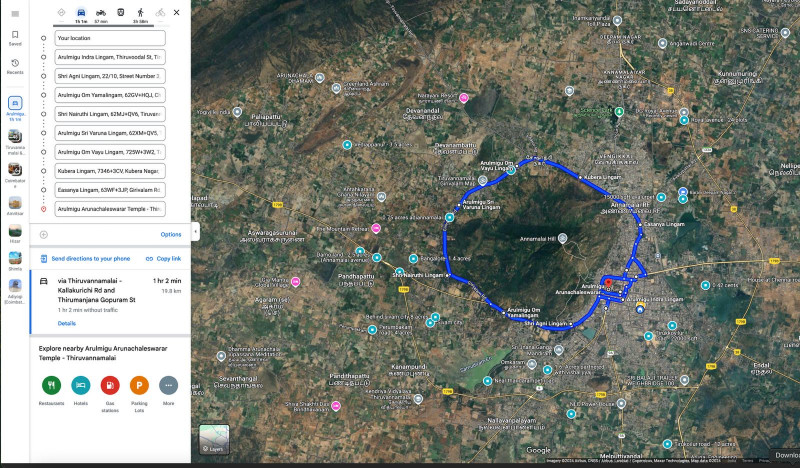- Oct 21, 2024
-
Introduction
The sacred town of Tiruvannamalai in Tamil Nadu, India, is known for its deep spiritual significance and the revered practice of Girivalam. Girivalam, or the circumambulation of Arunachala Hill, is a pilgrimage undertaken by millions of devotees each year, especially on Pournami (full moon) days. The path, which stretches for approximately 14 kilometres, is considered holy, as devotees believe that walking around the hill with faith can bring spiritual enlightenment, blessings, and the removal of past karmas. To make your journey more accessible and meaningful, using a Girivalam map is essential. In this guide, we'll explore everything you need to know about the Girivalam map, key locations along the path, and tips for a fulfilling pilgrimage.
Understanding the Girivalam Path
The Girivalam path (also known as Pradakshina) around Arunachala Hill covers a distance of 14 kilometres and is dotted with numerous shrines, sacred lingams, holy tanks, and natural spots of immense spiritual significance. The route can be confusing for first-time visitors, which makes having a Girivalam map incredibly useful for understanding the key landmarks along the way.
The path is usually walked barefoot, and pilgrims offer prayers and seek blessings at various shrines along the way. The Girivalam map helps devotees understand the location of these shrines and other important stops, allowing them to prepare adequately for the journey and ensuring they do not miss any significant spots.
Key Locations Marked on the Girivalam Map
The Girivalam map outlines the primary places of worship and other notable points along the sacred route. Here are some of the key landmarks marked on the map:
- Indra Lingam: This is the starting point of the Girivalam path. It is dedicated to Lord Indra, the king of gods, and is believed to bless devotees with prosperity.
- Agni Lingam: Located along the eastern side of the path, this shrine represents the fire element. It is said that offering prayers here helps in overcoming obstacles and purifies one’s inner self.
- Yama Lingam: This lingam is dedicated to Yama, the god of death. Prayers here are believed to remove fears of death and bless devotees with a long and healthy life.
- Niruthi Lingam: This lingam is associated with protection from negative influences. The Girivalam map shows its exact location along the route, helping devotees to easily find and offer prayers here.
- Varuna Lingam: Positioned near a holy tank, this lingam is dedicated to Varuna, the god of water. Praying here is believed to bless devotees with good health and purify their mind and body.
- Vayu Lingam: This lingam represents the air element and is believed to aid in mental clarity and peace. It is also a popular spot to rest and meditate.
- Kubera Lingam: Dedicated to Kubera, the god of wealth, this lingam is located on the western side of the path. Pilgrims pray here for financial stability and prosperity.
- Eesanya Lingam: Located at the northern part of the route, this lingam represents the final stage of the journey. It is believed that offering prayers here provides spiritual upliftment and brings divine blessings.
How to Use the Girivalam Map
The Girivalam map serves as a guide for planning your pilgrimage and understanding the location of key shrines and amenities along the route. Here are some essential tips for using the map effectively:
- Plan Your Start and End Point: Most pilgrims begin their Girivalam walk from Indra Lingam, which is marked clearly on the map. The path is circular, so you will eventually return to your starting point.
- Identify Rest Stops: The Girivalam map also marks important rest stops and water points, which can be especially helpful during a long walk. Knowing where these amenities are located can make your pilgrimage more comfortable.
- Look for Holy Tanks and Shrines: The map highlights the location of holy tanks where you can perform rituals and offer prayers. It also includes minor shrines along the way, which many pilgrims prefer to visit.
When to Perform Girivalam
Girivalam is particularly auspicious during Pournami (full moon) nights. The spiritual energy around Arunachala Hill is believed to be especially potent during this time, and thousands of devotees gather to perform Girivalam under the serene light of the full moon. The Girivalam map becomes even more crucial during these times as the route can become crowded, and navigating without knowing the key landmarks can be challenging.
The walk usually takes 4 to 5 hours, depending on the pace, and can be done at any time of the year. However, the full moon nights, Karthigai Deepam, and Shiva Ratri are the most popular times for the pilgrimage.
Tips for a Successful Girivalam
- Carry a Printed or Digital Girivalam Map: Whether you prefer a printed version or a digital map on your smartphone, having access to a Girivalam map will help you navigate the path with ease and ensure you don’t miss any important shrines.
- Stay Hydrated: The 14-kilometer path can be exhausting, especially in the heat. Make sure to carry water and take note of rest stops marked on the map.
- Walk Barefoot: It is customary to walk barefoot during Girivalam, as it signifies humility and devotion. Be prepared for different types of terrain and consider taking breaks if needed.
- Respect the Pilgrimage: Girivalam is a sacred journey, and maintaining a spiritual focus is important. Use the map to mark your progress and be mindful of the divine energy throughout the journey.
Conclusion
The Girivalam map is an invaluable tool for those embarking on this sacred journey around Arunachala Hill. Providing insights into the key locations along the path, it enhances the spiritual experience and ensures that devotees can make the most out of their pilgrimage. Whether you're a first-time pilgrim or someone who has walked the Girivalam route before, a detailed map can make the journey more meaningful and fulfilling.
Are you planning a trip to Tiruvannamalai for Girivalam? Contact Daga Developers to explore real estate opportunities close to this sacred pilgrimage path. Experience the spiritual tranquility of Arunachala every day.



Comments :
Currently, there are no comments in this post. Be the first person to comment on this post.